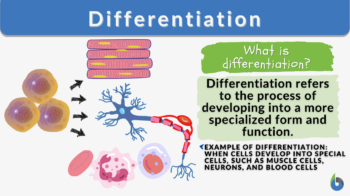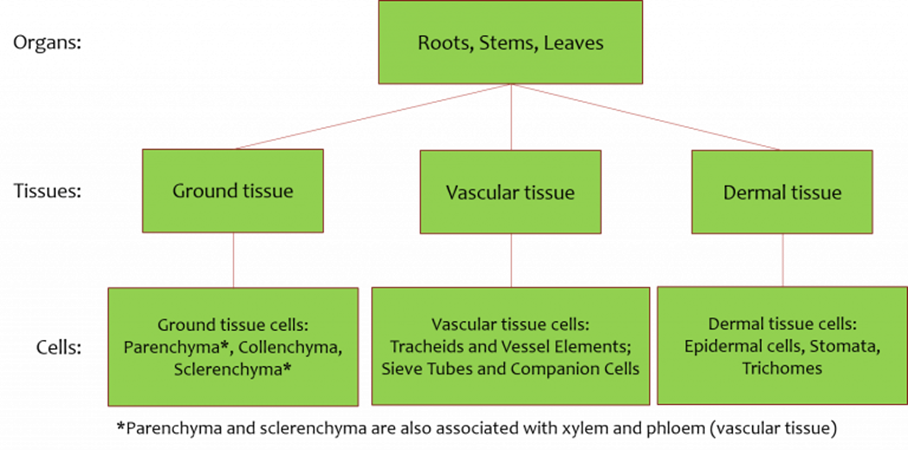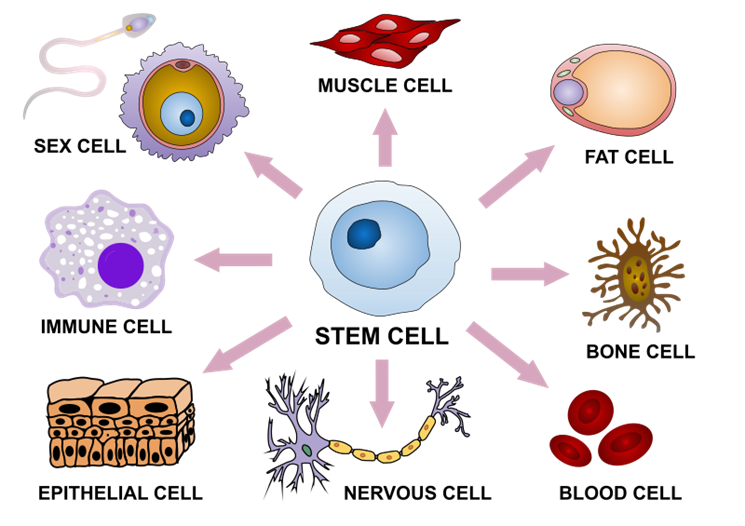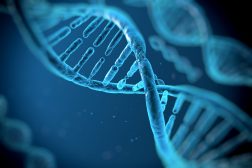
Differentiation
n., plural: differentiations
[ˌdɪfəˌrɛnʃɪˈeɪʃən]
Definition: a biological process wherein a less specialized cell develops to maturity with distinct form and function
Table of Contents
Differentiation in biology is the process where less specialized cells undergo changes to develop specialized structures and functions. Examples include nerve cells, muscle cells, and blood cells that develop through the regulation of specific genes and molecular signals during the development of an organism. Here, we will discuss about differentiation to answer the common question — What is differentiation in biology?
Differentiation Definition
In biology, differentiation refers to the process by which unspecialized or less-specialized cells acquire specialized structures and functions. During development, cells undergo differentiation to become distinct cell types with specific functions, such as nerve cells, muscle cells, or blood cells.
Differentiation is regulated by specific genes and molecular signals that activate or suppress certain genes, leading to changes in the cell’s structure and function. These changes can include modifications to the cell’s shape, size, membrane properties, and metabolic activity, as well as the expression of specific proteins and other molecules that allow the cell to carry out its specialized functions.
Watch this vid about cell differentiation:
In developmental biology, differentiation is the normal process by which a less specialized cell develops or matures to become more distinct in form and function. It is also called cell differentiation. Thus, to define differentiated, this refers to a cell having become distinct or “different” from the basic cell type, by having a more elaborate function and form. For example, a single-celled zygote develops into a multicellular embryo that further develops into a more complex multisystem of various cell types of a fetus. The cell size, shape, polarity, metabolism, and responsiveness to signals change dramatically such that the less specialized cell becomes more specialized and acquires a more specific role.See also: dedifferentiation.
Related forms:
- differentiated (adjective, a cell or tissue that experienced or has undergone differentiation, i.e. the form and function are altered from being generalized to being more specific)
- differentiate (verb, to become different, distinct, or specialized, especially in form or function; to undergo cell differentiation; to develop or mature; to evolve into a new species; to speciate)
Factors Influencing Cell Differentiation
Cell differentiation is a complex process that is influenced by a variety of factors, both intrinsic and extrinsic. Understanding these factors is important for developing strategies to control and manipulate cell fate, which has important implications for regenerative medicine and tissue engineering. Several factors can influence cell differentiation, including:
Cell signaling molecules
Signaling substances that attach to cell surface receptors and activate intracellular signaling pathways induce differentiation. EGF (epidermal growth factor) and FGF (fibroblast growth factor) can promote cell differentiation.
Gene expression
Gene expression can be regulated by a variety of factors, including epigenetic modifications and transcription factors. Changes in gene expression can trigger differentiation and determine the fate of a cell.
Cell-to-cell interactions
The interactions between neighboring cells can also influence cell differentiation. For example, the presence of certain cells in the microenvironment can promote or inhibit the differentiation of nearby cells.
Environmental cues
The physical and chemical properties of the microenvironment can also play a role in cell differentiation. For example, the stiffness of the extracellular matrix can influence cell fate, as can the presence of oxygen or other nutrients.
Timing and duration of signals
The timing and duration of signaling molecules can also influence cell differentiation. For example, a brief exposure to a signaling molecule may trigger a transient response, whereas sustained exposure may result in a more long-term change in gene expression and cell fate.
Cell Differentiation – Mechanism
Cell differentiation is a process that involves a series of steps by which a cell becomes specialized and assumes a particular function in the body. What is the step-by-step process of differentiation of cells? The mechanism of cell differentiation varies depending on the type of cell and the signaling molecules involved but generally involves the following steps:
Specification
In the first step of differentiation, a precursor cell becomes “specified” to develop into a particular type of cell. This is often triggered by exposure to signaling molecules that activate specific genetic pathways.
Determination
Once a cell is specified, it becomes “determined” to develop into a specific cell type. This involves a cascade of gene expression changes that activate or repress genes required for cell type-specific function.
Differentiation
In the differentiation step, the cell begins to acquire characteristics specific to its final cell type. This includes changes in morphology, gene expression, and biochemical function.
Maturation
In the final step of differentiation, the cell matures into its final form and function. This may involve additional gene expression changes, as well as changes in organelle function and protein expression.
Examples of Differentiation
Here are some differentiated cells examples.
Examples in Plants
Cell differentiation is a crucial process in plant development. In plants, cell differentiation occurs throughout development, and results in the formation of different types of structures, such as leaves, roots, stems, and flowers. Here are some examples of cell differentiation in plants:
- Xylem and phloem differentiation: Plant vascular tissue contains xylem and phloem, specialized cells that transfer water and nutrients. Phloem carries sugars and organic substances while the xylem carries water and minerals from the roots. Precursor cells differentiate into specialized xylem and phloem cells with diverse shapes, gene expressions, and functions.
- Root hair differentiation: Root hairs extend from root cells to promote nutrient absorption. Root hair differentiation involves the activation of genes involved in cell elongation, as well as the development of a specialized cell wall and plasma membrane.
- Leaf mesophyll differentiation: Leaves are composed of mesophyll cells, which are responsible for photosynthesis. Mesophyll differentiation involves the formation of chloroplasts, which is genes involved in photosynthesis.
- Flower development: The development of flowers involves the differentiation of different types of cells, such as sepals, petals, stamens, and carpels. This process is regulated by genes involved in floral development and is critical for successful pollination and reproduction.

Examples in Animals
Cell differentiation in animals involves the activation of specific genes and signaling pathways to transform undifferentiated cells into specialized cell types with distinct functions. Here are some examples of cell differentiation in animals:
- Muscle cell differentiation: Muscle cells are specialized cells that allow for movement and support in animals. Myoblasts, precursor cells that will become muscle cells, differentiate into myocytes, which are elongated and multinucleated cells that form muscle tissue. This process is controlled by the activation of specific transcription factors, such as MyoD and myogenin.
- Neuron differentiation: Neurons are specialized cells that transmit and process information in the nervous system. Neural stem cells differentiate into various types of neurons, such as motor neurons, sensory neurons, and interneurons, through a complex process that involves the activation of specific genes and signaling pathways.
- Blood cell differentiation: Blood cells are derived from hematopoietic stem cells, which differentiate into erythrocytes, leukocytes, and platelets. This process is controlled by the activation of specific transcription factors and signaling pathways and is crucial for the proper functioning of the immune system and oxygen transport.
- Epithelial cell differentiation: Epithelial cells, located in the skin and digestive tract, function as barriers and absorption. Epithelial cell differentiation activates genes and signaling pathways that regulate cell polarity, adhesion, and cell type.

Differentiation is a complex process that occurs during embryonic development but can also occur in adult tissues as part of tissue repair and regeneration. Dysregulation of differentiation can lead to developmental abnormalities or diseases such as cancer.
Question: What does differentiation mean in other science fields?
Differentiation in science:
Differentiation in science is the process of adding a range of instructional strategies into the science curriculum so that all students completely comprehend the material. Differentiation in science acknowledges that children learn in a variety of ways, and curriculum and instruction reflect this diversity.
Differentiation in geology:
There are three rock types in geology: igneous, sedimentary, and metamorphic. These rock types are distinguished based on their formation and composition. Sedimentary differentiation, for instance, refers to the progressive weathering by erosion and transportation and sorting for the initial formation of sedimentary rocks, which is a type of rock made up of deposits of pre-existing rocks and/or detritus that may be organic (remains of organisms) or inorganic. Well-sorted and rounded sediments are regarded as “mature”. (Sedimentary Rocks, 2023)
Differentiation definition in medicine:
In medicine, differentiation refers to the determination of which among the diseases with similar symptoms is the one that the patient is suffering from, especially through a systematic method.
Differentiation psychology:
In psychology, differentiation refers to the process of developing a distinct sense of self, separate from others and one’s environment. Human development requires the ability to understand and express one’s own and others’ thoughts, feelings, and needs.
Differentiation in calculus:
In calculus, implicit differentiation is a technique used to find the derivative of an implicitly defined function, which is a function that is not given in the form y = f(x). Instead, the function is defined implicitly by an equation that relates two variables, such as x and y. In this, a straight line can be represented by an equation (variable) that is not in the standard y = mx + b form. To find the derivative of an implicitly defined straight line, we use the chain rule of differentiation.
Basic differentiation rules require both theoretical knowledge and practical skills. Several basic differentiation rules are commonly used to find the derivative of a function, such as the power rule, constant rule, sum and difference rules, product rule, quotient rule, and chain rule. The difference rule is a basic rule of differentiation in calculus that states that the derivative of a difference between two functions is equal to the difference between their derivatives.
A differential equation is a type of differentiation equation that involves the derivatives of one or more functions. These derivatives represent the rates of change of the functions for the independent variable, such as time or space. The most common notation for a derivative is dy/dx, which represents the derivative of y for x.
Biologists apply differential calculus when computing the precise growth rate of bacteria in a culture medium, according to certain points or factors, such as temperature and nutrients.
Define differentiation in education:
Differentiation in education involves adapting instruction for students’ needs, interests, and skills to improve learning and academic performance. Differentiation creates a supportive learning environment where students can engage with the curriculum in ways that are relevant, challenging, and meaningful to them.
Differentiation definition in economics:
Differentiation in economics means making a product or service stand out from the competition to obtain market share. Offering unique features, perks, or quality may accomplish this.
Take the Differentiation – Biology Quiz!
References
- Basic differentiation rules. (2023a). Retrieved 01 April, 2023, from https://www.khanacademy.org/math/old-ap-calculus-ab/ab-derivative-rules/ab-basic-diff-rules/a/basic-differentiation-review#:~:text=The%20Difference%20rule%20says%20the,the%20derivative%20of%20the%20function.
- Perform implicit differentiation. (2023b). Retrieved 01 April, 2023, from https://www.khanacademy.org/math/ap-calculus-ab/ab-differentiation-2-new/ab-3-2/a/implicit-differentiation-review#:~:text=In%20implicit%20differentiation%2C%20we%20differentiate,%2C%20equals%2C%201%20for%20example.
- Differentiated Instruction. (2023). Retrieved 01 April, 2023, from https://www.readingrockets.org/article/what-differentiated-instruction#:~:text=Differentiation%20means%20tailoring%20instruction%20to,a%20successful%20approach%20to%20instruction.
- BYJU’S. (2023a). Cell Differentiation. Retrieved 01 April, 2023, from https://byjus.com/neet/cell-differentiation/
- BYJU’S. (2023b). Differential Equations. Retrieved 01 April, 2023, from https://byjus.com/maths/differential-equation/#:~:text=In%20Mathematics%2C%20a%20differential%20equation%20is%20an%20equation%20with%20one,one%20or%20more%20independent%20variables.
- Types of Rock. (2023). Retrieved 01 April, 2023, from https://www.amnh.org/exhibitions/permanent/planet-earth/how-do-we-read-the-rocks/three-types
- Merriam-Webster. (2023). differentiate. Retrieved 01 April, 2023, from https://www.merriam-webster.com/dictionary/differentiate#:~:text=%3A%20to%20recognize%20or%20give%20expression,distinct%20or%20different%20in%20character
- PsychAlive. (2023). Psychological Differentiation. Retrieved 01 April, 2023, from https://www.psychalive.org/psychological-differentiation/
- ShoreLight. (2023). Differentiation Science. Retrieved 01 April, 2023, from https://shorelight.com/student-stories/differentiation-science-lessons/
- Sedimentary Rocks. (n.d.). Retrieved April 5, 2023, from https://www.craftonhills.edu/faculty-and-staff/personal-pages/rhughes/documents/sedimentary-rocks.pdf
©BiologyOnline.com. Content provided and moderated by Biology Online Editors.










